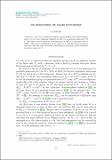On induction of class functions
Author(s)
Lusztig, George
DownloadPublished version (199.2Kb)
Publisher Policy
Publisher Policy
Article is made available in accordance with the publisher's policy and may be subject to US copyright law. Please refer to the publisher's site for terms of use.
Terms of use
Metadata
Show full item recordAbstract
<p>Let <inline-formula content-type="math/mathml">
<mml:math xmlns:mml="http://www.w3.org/1998/Math/MathML" alttext="upper G">
<mml:semantics>
<mml:mi>G</mml:mi>
<mml:annotation encoding="application/x-tex">G</mml:annotation>
</mml:semantics>
</mml:math>
</inline-formula> be a connected reductive group defined over a finite field <inline-formula content-type="math/mathml">
<mml:math xmlns:mml="http://www.w3.org/1998/Math/MathML" alttext="bold upper F Subscript q">
<mml:semantics>
<mml:msub>
<mml:mrow class="MJX-TeXAtom-ORD">
<mml:mi mathvariant="bold">F</mml:mi>
</mml:mrow>
<mml:mi>q</mml:mi>
</mml:msub>
<mml:annotation encoding="application/x-tex">\mathbf {F}_q</mml:annotation>
</mml:semantics>
</mml:math>
</inline-formula> and let <inline-formula content-type="math/mathml">
<mml:math xmlns:mml="http://www.w3.org/1998/Math/MathML" alttext="upper L">
<mml:semantics>
<mml:mi>L</mml:mi>
<mml:annotation encoding="application/x-tex">L</mml:annotation>
</mml:semantics>
</mml:math>
</inline-formula> be a Levi subgroup (defined over <inline-formula content-type="math/mathml">
<mml:math xmlns:mml="http://www.w3.org/1998/Math/MathML" alttext="bold upper F Subscript q">
<mml:semantics>
<mml:msub>
<mml:mrow class="MJX-TeXAtom-ORD">
<mml:mi mathvariant="bold">F</mml:mi>
</mml:mrow>
<mml:mi>q</mml:mi>
</mml:msub>
<mml:annotation encoding="application/x-tex">\mathbf {F}_q</mml:annotation>
</mml:semantics>
</mml:math>
</inline-formula>) of a parabolic subgroup <inline-formula content-type="math/mathml">
<mml:math xmlns:mml="http://www.w3.org/1998/Math/MathML" alttext="upper P">
<mml:semantics>
<mml:mi>P</mml:mi>
<mml:annotation encoding="application/x-tex">P</mml:annotation>
</mml:semantics>
</mml:math>
</inline-formula> of <inline-formula content-type="math/mathml">
<mml:math xmlns:mml="http://www.w3.org/1998/Math/MathML" alttext="upper G">
<mml:semantics>
<mml:mi>G</mml:mi>
<mml:annotation encoding="application/x-tex">G</mml:annotation>
</mml:semantics>
</mml:math>
</inline-formula>. We define a linear map from class functions on <inline-formula content-type="math/mathml">
<mml:math xmlns:mml="http://www.w3.org/1998/Math/MathML" alttext="upper L left-parenthesis bold upper F Subscript q Baseline right-parenthesis">
<mml:semantics>
<mml:mrow>
<mml:mi>L</mml:mi>
<mml:mo stretchy="false">(</mml:mo>
<mml:msub>
<mml:mrow class="MJX-TeXAtom-ORD">
<mml:mi mathvariant="bold">F</mml:mi>
</mml:mrow>
<mml:mi>q</mml:mi>
</mml:msub>
<mml:mo stretchy="false">)</mml:mo>
</mml:mrow>
<mml:annotation encoding="application/x-tex">L(\mathbf {F}_q)</mml:annotation>
</mml:semantics>
</mml:math>
</inline-formula> to class functions on <inline-formula content-type="math/mathml">
<mml:math xmlns:mml="http://www.w3.org/1998/Math/MathML" alttext="upper G left-parenthesis bold upper F Subscript q Baseline right-parenthesis">
<mml:semantics>
<mml:mrow>
<mml:mi>G</mml:mi>
<mml:mo stretchy="false">(</mml:mo>
<mml:msub>
<mml:mrow class="MJX-TeXAtom-ORD">
<mml:mi mathvariant="bold">F</mml:mi>
</mml:mrow>
<mml:mi>q</mml:mi>
</mml:msub>
<mml:mo stretchy="false">)</mml:mo>
</mml:mrow>
<mml:annotation encoding="application/x-tex">G(\mathbf {F}_q)</mml:annotation>
</mml:semantics>
</mml:math>
</inline-formula>. This map is independent of the choice of <inline-formula content-type="math/mathml">
<mml:math xmlns:mml="http://www.w3.org/1998/Math/MathML" alttext="upper P">
<mml:semantics>
<mml:mi>P</mml:mi>
<mml:annotation encoding="application/x-tex">P</mml:annotation>
</mml:semantics>
</mml:math>
</inline-formula>. We show that for large <inline-formula content-type="math/mathml">
<mml:math xmlns:mml="http://www.w3.org/1998/Math/MathML" alttext="q">
<mml:semantics>
<mml:mi>q</mml:mi>
<mml:annotation encoding="application/x-tex">q</mml:annotation>
</mml:semantics>
</mml:math>
</inline-formula> this map coincides with the known cohomological induction (whose definition involves a choice of <inline-formula content-type="math/mathml">
<mml:math xmlns:mml="http://www.w3.org/1998/Math/MathML" alttext="upper P">
<mml:semantics>
<mml:mi>P</mml:mi>
<mml:annotation encoding="application/x-tex">P</mml:annotation>
</mml:semantics>
</mml:math>
</inline-formula>).</p>
Date issued
2021-05-07Department
Massachusetts Institute of Technology. Department of MathematicsJournal
Representation Theory of the American Mathematical Society
Publisher
American Mathematical Society (AMS)